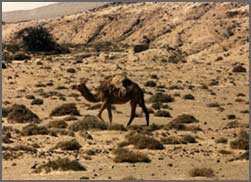Biosphere Contents
5. Development
Specialisation is an evolutionary strategy by which a species becomes adapted to survive in a narrow range of environmental conditions or to adopt a limited diet. It may be associated with the adoption of characteristics protecting a species against the stresses of extreme environments

Desert areas provide a wealth of examples of specialisation. Faced with extended droughts and extreme temperatures a number of survival strategies have evolved: (a) avoidance of drought through rapid flowering and fruiting in the favourable periods following rainfall, with dormancy during the long arid periods; (b) tolerance of drought by reducing the water needs of the plant, through short stature (thus avoiding wind related water loss), by leaf rolling, and by reducing leaf surface area to minimise water loss through transpiration (c) storage of water in succulent stems or leaves (e.g. cacti) ; (d) the development of long rooting systems to reach lowered ground water tables.
Animals may also show specialisations for surviving periods of drought. Camels for example, store water (as fat) in their humps, and are famous for their abilities to survive for long periods without drinking.
Plants and animals can adapt to the stresses that are prevalent in the natural environment if given sufficient time. The key is that the rate of environmental change should not occur at a rate faster than that at which the species can respond.
Can you give some examples of species adaptation (through specialisation) to stress?